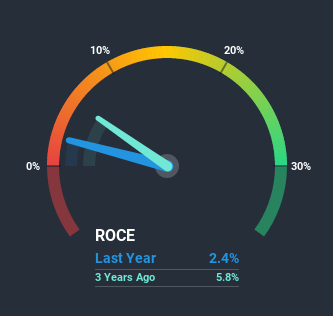- South Korea
- /
- Machinery
- /
- KOSDAQ:A051490
What Nara Mold & Die's (KOSDAQ:051490) Returns On Capital Can Tell Us

Ignoring the stock price of a company, what are the underlying trends that tell us a business is past the growth phase? A business that's potentially in decline often shows two trends, a return on capital employed (ROCE) that's declining, and a base of capital employed that's also declining. This indicates the company is producing less profit from its investments and its total assets are decreasing. Having said that, after a brief look, Nara Mold & Die (KOSDAQ:051490) we aren't filled with optimism, but let's investigate further.
What is Return On Capital Employed (ROCE)?
For those who don't know, ROCE is a measure of a company's yearly pre-tax profit (its return), relative to the capital employed in the business. To calculate this metric for Nara Mold & Die, this is the formula:
Return on Capital Employed = Earnings Before Interest and Tax (EBIT) ÷ (Total Assets - Current Liabilities)
0.024 = ₩2.4b ÷ (₩226b - ₩129b) (Based on the trailing twelve months to September 2020).
Therefore, Nara Mold & Die has an ROCE of 2.4%. In absolute terms, that's a low return and it also under-performs the Machinery industry average of 5.4%.
View our latest analysis for Nara Mold & Die

While the past is not representative of the future, it can be helpful to know how a company has performed historically, which is why we have this chart above. If you want to delve into the historical earnings, revenue and cash flow of Nara Mold & Die, check out these free graphs here.
What Does the ROCE Trend For Nara Mold & Die Tell Us?
In terms of Nara Mold & Die's historical ROCE movements, the trend doesn't inspire confidence. To be more specific, the ROCE was 7.7% five years ago, but since then it has dropped noticeably. And on the capital employed front, the business is utilizing roughly the same amount of capital as it was back then. Companies that exhibit these attributes tend to not be shrinking, but they can be mature and facing pressure on their margins from competition. So because these trends aren't typically conducive to creating a multi-bagger, we wouldn't hold our breath on Nara Mold & Die becoming one if things continue as they have.
While on the subject, we noticed that the ratio of current liabilities to total assets has risen to 57%, which has impacted the ROCE. Without this increase, it's likely that ROCE would be even lower than 2.4%. What this means is that in reality, a rather large portion of the business is being funded by the likes of the company's suppliers or short-term creditors, which can bring some risks of its own.
The Key Takeaway
In the end, the trend of lower returns on the same amount of capital isn't typically an indication that we're looking at a growth stock. Yet despite these poor fundamentals, the stock has gained a huge 233% over the last five years, so investors appear very optimistic. In any case, the current underlying trends don't bode well for long term performance so unless they reverse, we'd start looking elsewhere.
One final note, you should learn about the 3 warning signs we've spotted with Nara Mold & Die (including 2 which don't sit too well with us) .
While Nara Mold & Die isn't earning the highest return, check out this free list of companies that are earning high returns on equity with solid balance sheets.
When trading Nara Mold & Die or any other investment, use the platform considered by many to be the Professional's Gateway to the Worlds Market, Interactive Brokers. You get the lowest-cost* trading on stocks, options, futures, forex, bonds and funds worldwide from a single integrated account. Promoted
Valuation is complex, but we're here to simplify it.
Discover if Nara Mold & Die might be undervalued or overvalued with our detailed analysis, featuring fair value estimates, potential risks, dividends, insider trades, and its financial condition.
Access Free AnalysisThis article by Simply Wall St is general in nature. It does not constitute a recommendation to buy or sell any stock, and does not take account of your objectives, or your financial situation. We aim to bring you long-term focused analysis driven by fundamental data. Note that our analysis may not factor in the latest price-sensitive company announcements or qualitative material. Simply Wall St has no position in any stocks mentioned.
*Interactive Brokers Rated Lowest Cost Broker by StockBrokers.com Annual Online Review 2020
Have feedback on this article? Concerned about the content? Get in touch with us directly. Alternatively, email editorial-team (at) simplywallst.com.
About KOSDAQ:A051490
Nara Mold & Die
Engages in the manufacture and sale of press dies, plastic molds, stamped parts, and assembly parts in South Korea.
Excellent balance sheet and good value.
Market Insights
Community Narratives



